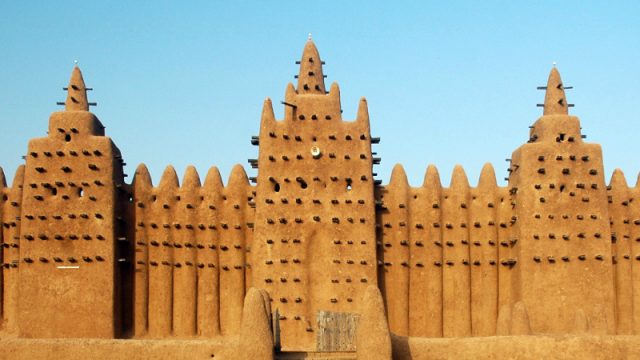Mali is often overlooked by travelers heading to West Africa for a vacation. Many decide instead to visit neighboring countries on the coast. But we can think of at least three reasons to visit Mali: its fascinating culture, breathtaking landscapes, and legendary cities. If you’re headed to the region, don’t leave without checking out some of these incredible sights. (Note: A military coup in 2012 disrupted the political stability of Mali, and some areas may not be safe for travel.)
Sources: Wikipedia.org, Travel.Michelin.com, MapsofWorld.com, FrontiersofTravel.com, IGoUGo.com, PureTravel.com, SmartTraveller.gov.au
This article originally appeared on AFKInsider.com.
Bandiagara Cliffs
Located in the Dogon country in Mali, the Bandiagara Cliffs are a 135-kilometer escarpment of cliffs and sandy plateaus that rise more than 500 meters above the flats to the south. Once considered a UNESCO World Heritage site (1989), the cliffs end with the Hombori Tondo, Mali’s highest peak, at 1,115 meters. The result is an incredibly imposing and magnificent set of peaks that rise high above the rest of the country.
Festival sur le Niger
Each February, an enormous festival is held in Ségou, Mali, known as the Festival on the Niger. Since 2005, the festival has drawn an enormous variety of talented artists, and prominently features African artists. Aside from the big-name stars, young singers and dancers are also given the opportunity to take the stage, and the festival draws thousands of attendees each year.
Boucle du Baoulé National Park
While Boucle du Baoulé National Park isn’t known for its wildlife — unlike many other national parks in Africa — it contains a large and unique collection of prehistoric rock art and tombs. The park was added to the UNESCO World Heritage “tentative” list in 1999, and draws thousands of visitors each year.
Woroni Falls
Some of the most impressive waterfalls in the country, the Woroni Falls (also known as les Chutes de Woroni) fall more than 20 meters from imposing cliff faces to form natural pools that are open to the public for swimming. Surrounded by lush greenery, the Woroni Falls are a popular spot for travelers looking to take a dip, have a picnic, or even get married!
Niger River
The Niger River, the third longest in Africa, is a sight unto itself, but also worth a visit for all of the unique adventure opportunities it offers visitors. River cruises on traditional wooden vessels are a popular option, and there are many spots where you can camp amid the lush landscape and see some of Mali’s wildlife, including hippos and numerous exotic bird species.
Bamako Hills and Caves
If you’re staying in the capital city of Bamako, be sure not to miss the hills and caves just outside the city center. Inhabited since early times, the caves are packed with wall paintings and the like, and the view from the hillside overlooking the city is phenomenal!
Koima Dune
If you have the fitness level (or the four-wheel drive vehicle) to make it to the top of “La Dune Rose de Koima” (the pink dune of Koima), head up there at sunset for an incredible view of the Niger River and the surrounding desert, stretching as far as the eye can see. You can go at other times besides sunset, of course, but the pink sky makes the experience extra special.
Mount Hombori
The highest point in Mali, Mount Hombori is an incredible sight to see not only from afar, but also from up close, as it’s an extremely significant archaeological site. Its caves were inhabited thousands of years ago, and are still filled with ancient paintings and artifacts that visitors can view.
Tomb of Askia
Thought to be the burial place of Askia Mohammad I, one of the Songhai Empire’s most notable emperors, the tomb of Askia was built in 1495 and is an incredible testament to the mud-building traditions of the West African Sahel. It is the largest pre-colonial architectural monument in the region, and its unique style speaks volumes about the country’s former empires.
Mopti
Mopti, a town in the Inner Niger Delta region, is known as the “Venice of Mali” because of its commerce and cultural monuments. The most famous structure is the mud-brick Grand Mosque, built in 1908, which is a UNESCO World Heritage site. The city also functions as a busy trading port, as it sits at the confluence of the Niger and Bani rivers.
Djenné
Djenné, which is located about 80 miles (130km) from Mopti, offers more examples of Mali’s distinctive Sudanese-style mud-brick architecture. It has its own Grand Mosque, as well as hundreds of two-story dwellings with incredible facades. They are constructed from hard-packed, dried adobe bricks that are covered in plaster, which is made from earth and rice husks. Djenné, along with the nearby ruins of Djenné-Jéno, are collectively another UNESCO World Heritage Site.
Timbuktu
Though many think that Timbuktu only exists in legends and myths, it’s an actual town in central Mali that was once an important trading post and center of Islamic scholarship. Though it’s now a remote, impoverished village that’s slowly being consumed by the Sahara desert, a trickle of determined tourists still arrive every year to see its mud-brick mosques, mausoleums, manuscripts and markets. It’s also the site of the annual Festival au Désert, which showcases mainly Tuareg music.
Related content on AFKTravel:
10 Things You Didn’t Know About The Ancient Mali Empire
Photo Essay: The Incredible Sights Of Mali
15 Things You Didn’t Know About The Dogon People Of Mali
Want to discover the finer side of Africa? Sign up for our weekly newsletter.

